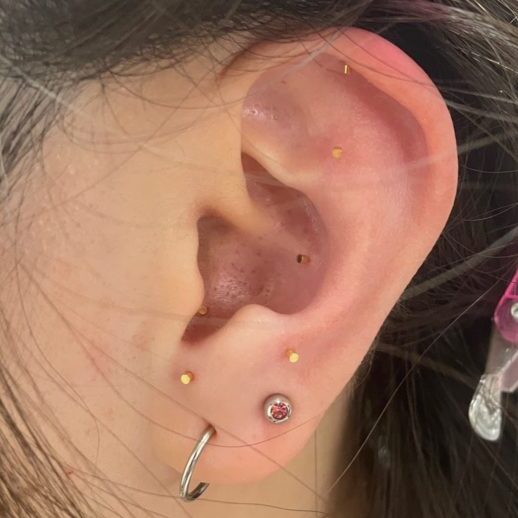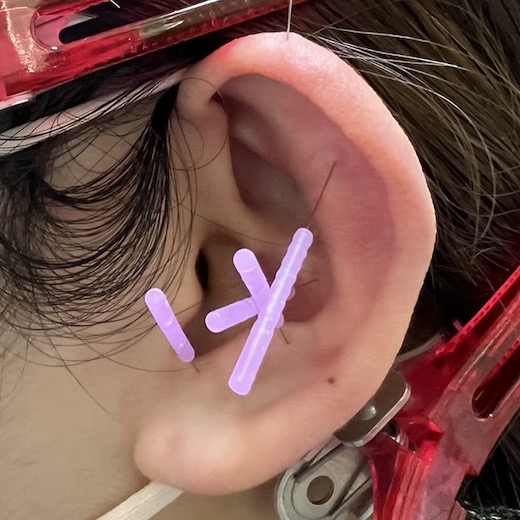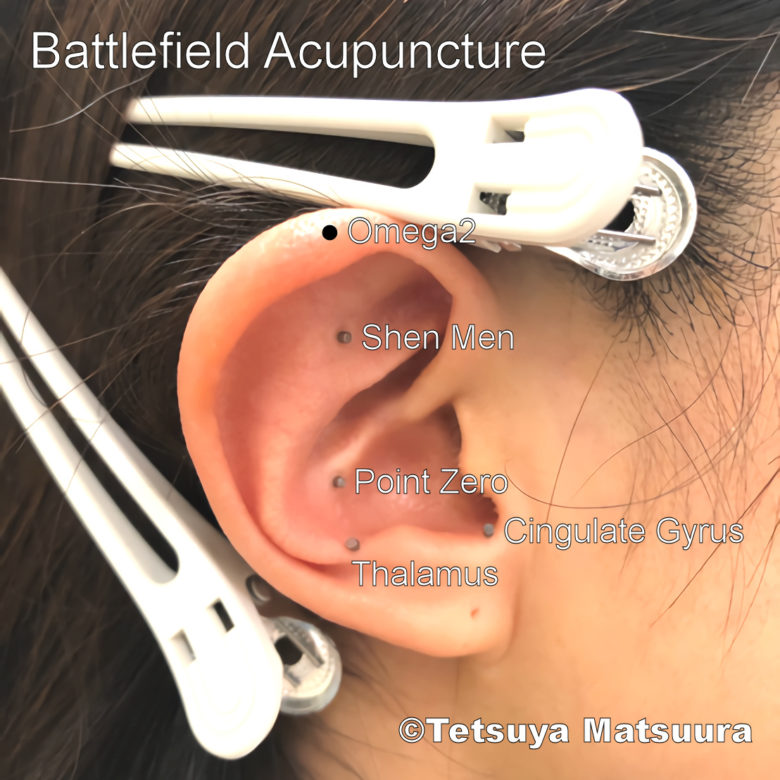

米空軍の軍医が提唱する疼痛管理に優れた施術法
Battlefield Acupuncture(戦場鍼、以下BFA)とは、米空軍の軍医であったDr.Richard Niemtzow(ニムゾフ退役軍医大佐)が2001年に名付けた鍼法で、疼痛管理に有用として知られている耳の部位に鍼などによる刺激をする施術法です。
BFAの効果を期待する症状
- 急性および慢性疼痛症候群
- 片頭痛
- PTSD
- うつ病/不安
- ストレス誘発性無関心と不眠症
- 術前/術後疼痛補助

耳は戦場や病床で刺鍼しやすく、即効のため、米軍軍医を対象とした鍼の生涯教育の中でも教育されている施術方法です。
Dr.Richard Niemtzow(ニムゾフ退役軍医大佐)が研究の末に導き出した5っのポイント(写真参照)に鍼などによる刺激をするだけというシンプルな治療方法ですが、再現性と即効性に優れています。
BFAの禁忌は下記の通りと本国では云われているようです。
- 妊娠または妊娠の可能性のある患者
- 出血障害のある患者
- 針を嫌う患者
- 針に対する嫌悪の個人歴、又は針に対する血管迷走神経反射のある患者
- 刺鍼部位に感染症がある患者
- Active Flight Duty(活発な飛行任務には適さない)
引用元:Battlefield Acupuncture Handbook
5っのポイントへの刺激には大まかには毫鍼を使った方法とASPを使った方法があり、刺激にASPを使った場合は平均して約75%に疼痛の軽減があるとこの論文で報告されています。
実際にBattlefield Acupunctureを受けた患者さんの感想
日本でBattlefield Acupunctureが75%に有効だと云われている原因はこの論文だと思われる
Acupuncture Today – April, 2009, Vol. 10, Issue 04
Battlefield Acupuncture for the Clinical Practitioner
Battlefield Acupuncture for the Clinical Practitioner
BY JOHN AMARO, LAC, DC, DIPL. AC.(NCCAOM), DIPL.MED.AC.(IAMA)
Recently, I have received several requests for information on battlefield acupuncture. The term battlefield acupuncture was first used in 2001 by my friend and colleague Col. Richard Niemtzow MD, PhD, who serves as a consultant for complementary and alternative medicine to the Surgeon General of the Air Force. I have served with him on the Board of Directors of the Auriculotherapy Certification Institute.
It has just been announced that the U.S. Air Force will begin training physicians being deployed to Iraq and Afghanistan. The treatment uses small needles in the skin of the ear to block pain in as few as five minutes and can last for several days or longer. The procedure was initially introduced in 2008 at Landstuhl Regional Medical Center (LRMC), where it was applied to wounded service members and local patients for pain relief, with significant results. The hospital, located near Ramstein Air Base in Germany, is the largest and most modern U.S. military medical facility outside the United States.
One of the pain specialists at LRMC personally experienced a 25 percent increased range of motion and a 50 percent reduction in pain for chronic shoulder and upper back pain he endured for several years. As a result of his outstanding success, he recruited his most challenging patients for whom traditional pain treatment offered limited relief. Within minutes of the needles being inserted, many said their pain had been reduced by up to 75 percent. A 25 percent reduction would be considered a success with traditional pain medications.
Despite its name, battlefield acupuncture is not purposely designed to replace standard medical care for war-related injuries but to assist in pain relief and in many cases eliminate the need for pain medication for acute and chronic pain. It is extremely easy to learn and may be taught to anyone in an extremely short time. The procedure allows a provider to confidently complete a treatment and expect a good result within minutes. There are virtually no complications and patients are subjected to little or no discomfort.
It was reported that only approximately 15 percent of patients do not respond to acupuncture, but of those who do, their pain reduction often averages about 75 percent. The frequency of application and the duration of relief vary with each patient, but treatment can progress from about two times a week to as little as once a month or longer. In some cases, further acupuncture treatment may not be required.
There are five specific points which are classically used, however many practitioners only use two. The five points are: Wonderful Point (also known as Point Zero), Shen Men, Omega 2, Thalamus and the Cingulate Gyrus. The Cingulate Gyrus point and the Thalamus are the two points which all practitioners will use.
As in so many acupuncture procedures, practitioners may place the points in different locations. The Cingulate Gyrus has also been called the Subcortex by Terry Oleson, PhD (international authority on auriculotherapy). Beate Strittmatter, MD, a German authority places it slightly differently (see Illustration). Personally, I use both locations just to make sure I cover all of my bases.
The Omega 2 point is on the internal of the helix. Due to the thinness of the auricle at this point, any stimulation from the exterior will contact the Omega 2 point. Some may wish to approach this point from the interior, but I personally go from the exterior.
The Thalamus point is directly opposite on the internal side of the exterior points known as the Temple or Sun. Most battlefield acupuncture practitioners approach the Thalamus from the internal position. However, I have always felt this point could be accessed as easily by stimulation of the Temple (Sun) points from the exterior and have used it that way for years.
The official procedure uses gold semi-permanent needles, which are placed directly into the point and left to fall out on their own in a day or two. I have seen marvelous results with low-level laser directly to the points, as well as electronic stimulation. Conventional acupuncture needles may be stimulated for 10 minutes. Then use an acu-patch, which is a small stimulation sphere attached by flesh-colored adhesive. This can be left in place for several days or longer.
This procedure is too valuable to overlook in your general practice. It is easy, quick and effective. Do not limit yourself to just acute or chronic pain with this combination of points. It is also extremely effective in anxiety, neurosis, neurasthenia and any psychological or stress related issues.
この論文にて、鍼治療に反応する患者のうち、疼痛の軽減は平均約75%の患者に認められると記述されているのが、日本に於いては戦場鍼治療は75%有効と独り歩きした話になっているのだと思われる。
